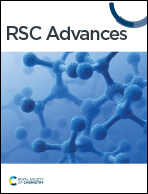Effects of different tempering temperatures on the properties of industrial sheet margarine†
Abstract
Tempering is the final step in Industrial Sheet Margarine (ISM) production, which has a substantial influence on the structure and application characteristics. There are limited reports on how the tempering process affects the ductility and application characteristics of ISM at an industrial production scale. Herein, we investigated the physicochemical properties and ductility of the ISM made from interesterification and non-interesterification fat at various tempering temperatures (10, 15, 20, 25, and 30 °C) for 5 days. By analyzing the triacylglycerol (TAG) compositions, polymorphism, thermal behavior and hardness of ISMs under different formulations and tempering conditions, the interaction between the physicochemical parameters and the application properties such as bending and sheeting abilities was elucidated. The results showed that low tempering temperatures (10 °C and 15 °C) led to higher hardness (>700 g) while high tempering temperature (30 °C) promoted polymorph transition (β′ → β), further directing to poor crystallization behavior, poor plasticity and malleability. Products tempered at 20 °C and 25 °C exhibited optimal ductility properties. These findings provided practical guidance to improve the ductility of sheet margarine in industrial level production.



 Please wait while we load your content...
Please wait while we load your content...